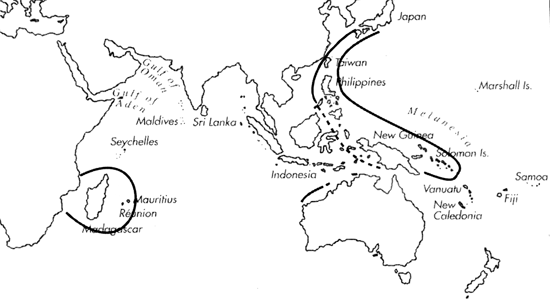
Skip Navigation Links
View access keys for this site.

Range: Japan to Philippines and Solomon Is.; also recorded from Mozambique, Madagascar, and Re'union.
Description: Moderately large to large, moderately solid to solid. Last whorl narrowly conical, conical or ventricosely conical; outline convex adapically, less so or straight below. Shoulder angulate to rounded. Spire of low to moderate height, outline straight to slightly convex. Larval shell of 3-3.5 whorls, maximum diameter about 1 mm. First 3.5-6 postnuclear whorls tuberculate. Teleoconch sutural ramps almost flat, with 2- 4 increasing to 5-9 variably spaced spiral grooves; latest ramps usually with additional spiral striae. Basal third or sometimes half of last whorl with weak to pronounced, variably spaced spiral ribs occasionally grading to ribbons posteriorly.
| Shell Morphometry | ||
|---|---|---|
| L | 55-94 mm | |
| RW | 0.20-0.77 g/mm | |
| RD | 0.48-0.58 | |
| PMD | 0.76-0.91 | |
| RSH | 0.07-0.18 | |
Colour pale bluish to greyish violet, with scattered bluish grey streaks, dashes or spots on last whorl. Dark coloured and heavily patterned shells intergrade with light coloured and almost patternless ones. Usual pattern of last whorl with 3 interrupted or continuous reddish brown spiral bands, below shoulder and on both sides of centre; areas between variably mottled with reddish brown triangles, dots and axial lines; overlying spiral rows of brown dots and dashes vary considerably, and often contain light dashes abapically. Base and siphonal fasciole often grey. Larval whorls white to brown. In typically patterned shells, teleoconch sutural ramps crossed by reddish to blackish brown streaks and blotches; in light-coloured shells, pattern reduction matches that of last whorl. Aperture white.
Periostracum olive, thin and translucent, with widely spaced or irregularly set tufted spiral ridges on last whorl; adapical ridges usually more closely set and sometimes obsolete, shoulder strongly or weakly tufted.
Habitat and Habits: In 20-240 m; in Philippines, form tamikoae in 240-400 m.
Discussion: C. kinoshitai resembles C. fulmen; in particular, the colour form calliginosus of C. kinoshitai (see below) resembles form kirai and form wistaria of C. fulmen in the plain pattern of brown spiral bands and interrupted lines. C. fulmen differs in its generally broader last whorl (RD 0.55-0.62), weaker spiral sculpture of the late sutural ramps, bright orange-red larval shell, and in its broader and darker blotches on the spire. In addition, its periostracum is darker, thicker and opaque and lacks tufted spiral ridges. Typical shells of these two species are easier to distinguish, because C. fulmen has a predominant colour pattern of dark brown axially arranged blotches and spiral lines, rather than the interrupted reddish brown spiral bands of C. kinoshitai. C. tamikoae (Pl. 16, Figs. 12, 15) refers to a yellow colour variant of C. kinoshitai. Shikama used two spellings for this taxon: C. tamikoae with the description, C. tamikoana with the figures. We have accepted the first spelling. Form calliginosus (Pl. 16, Fig. 14) is based on pale greyish violet shells with a variably reduced pattern and narrow last whorl. C. brontodes (Pl. 16, Fig. 13) most probably refers to a large subadult specimen of C. kinoshitai with an exceptional low spire and conical shape.

C. kinoshitai range map
This section contains verbatim reproductions of the accounts of 316 species of Conus from the Indo-Pacific region, from Manual of the Living Conidae, by Röckel, Korn and Kohn (1995). They are reproduced with the kind permission of the present publisher, Conchbooks.
All plates and figures referred to in the text are also in Röckel, Korn & Kohn, 1995. Manual of the Living Conidae Vol. 1: Indo-Pacific Region.
The range maps have been modified so that each species account has it own map, rather than one map that showed the ranges of several species in the original work. This was necessary because each species account is on a separate page on the website and not confined to the order of accounts in the book.
Return to framed version (returns to search page)